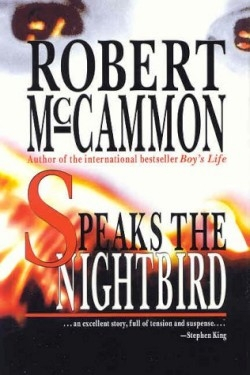Speaks the Nightbird
In Colonial South Carolina, the settlement of Fount Royal awaits the arrival of a magistrate from Charles Town who will decide the fate of an accused witch, Rachel Howarth. The year is 1699, and settlements on the edge of the wilderness teeter between civilization and savagery. Into this cauldron marches Magistrate Woodward, a true judge, a fair and honest man. With his clerk, Matthew, Woodward traverses the territory between Charles Town and Fount Royal, through “a joyful day for frogs and mudhens,” but for the two travelers, “chill rain coiled chains around the soul.” So this tale of mystery and moral courage begins, crafted by the award-winning author of numerous short stories and fourteen novels, including the best-selling Gone South.
McCammon brings the trembling boundary between the seventeenth and eighteenth centuries alive through Matthew’s discerning eye. Customs, clothing, and beliefs are evident in every scene. For example, one townswoman intends to sell locks of the accused witch’s hair as good fortune charms, and seeks to capitalize on the burning by selling cakes and pies. A wasps’ nest hangs above this woman’s dining table to rid her home of mosquitoes. The mayor’s home offers Colonial meals, from “coarse-grained jonakin bread that tasted of burnt corn” to “toss ’em boys,” greasy roast chicken.
In every corner of the town lies the shadow of Rachel Howarth. People are so afraid that many have abandoned Fount Royal. However, Matthew questions whether Rachel is a witch, or a pawn in an elaborate and desperate game. He sees pieces of the puzzle that don’t fit, and asks questions that find no answers. Woodward frets about his clerk. He sees Matthew’s search for truth as the pursuit of a “nightbird,” and worries that his desire to prove that Rachel is not a witch will lead Matthew to ruin.
Speaks the Nightbird is rendered in vivid scenes with exquisite historical detail, dropping the reader into the fictional dream, and into the dawn of the eighteenth century, when reason sought to overcome superstition. Caught in this dilemma is Matthew, who asks why it was only the English citizens, not the German or slave population of Fount Royal, who witnessed Rachel performing unspeakable acts? Why are pearls and gold pieces found in the bellies of turtles? Each clue stacks upon another as Matthew races to discover the truth, only to find that truth wears many faces, and the nightbird he chases propels him to his own soul.
Reviewed by
Carol Lynn Stewart
Disclosure: This article is not an endorsement, but a review. The publisher of this book provided free copies of the book to have their book reviewed by a professional reviewer. No fee was paid by the publisher for this review. Foreword Reviews only recommends books that we love. Foreword Magazine, Inc. is disclosing this in accordance with the Federal Trade Commission’s 16 CFR, Part 255.


